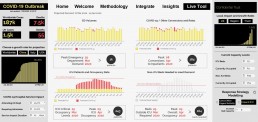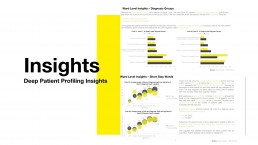Since the very outset of the virus, we have been working around the clock, resolute in developing a way to be able to support patients and providers in this time of crisis. As warnings from both around the world and within our own health service begin to flood the media, what is apparent is that while the majority of COVID-19 cases are predicted to be relatively mild, the proportion of those that do require critical and intensive care will quickly overwhelm a system already at full capacity. With beds in short supply alongside doctors and nurses who are currently stretched thin, proper preparation for the upcoming waves of demand will be crucial.

Already, countries such as China, Iran, Italy and the USA have endured significant spreading of coronavirus throughout their populations. As we continue to see increased COVID-19 cases across the country at our own Emergency Departments (ED), our company remains determined to learn from those already in the midst of an outbreak, ensuring that we play an active role in supporting our health system, colleagues, and patients in the face of COVID-19’s impact on the world. It is vital to us that we provide help at a time where more and more patients are being admitted to wards, both overall and in ICU. Our drive to do so has resulted in the creation of the COVID-19 NHS Live Demand Impact Assessment Tool (IAT), working to further enhance the existing arsenals of trusts across the country.

Tracking the situation on the ground
As of today, we have released the IAT to a select number of hospitals, helping to provide impact assessment from a provider perspective. This allows trusts to view and analyse national Hospital Episode Statistics (HES) data, alongside a number of live data sources on COVID-19 cases by the minute, as they emerge across the globe. The IAT instantly models the impact of increased volume and complexity at a local and system level, providing visibility of ICU, theatres, and overall bed impact, in addition to connecting these to each trust’s clinical workforce. By linking the tool with local data, it is able to show immediate impacts on beds and staff under a range of selected scenarios. In tandem with this, we have created a feature within the tool which further works in the trust-level situation on a running basis, bringing in factors such as their pathology and radiology data to run live against ED activity. From this, providers will be able to assess the impact of COVID-19 upon their organisation on a daily basis, and it is our strong belief that this ability to monitor, plan and predict the needs of health systems will be an important foundation in tackling the coronavirus crisis.

Reports from countries hard hit by COVID-19 have repeatedly warned of the effects on the healthcare workforce, with doctors, nurses, and the team as a whole on the frontlines of battling the virus often falling victim to it themselves. In the early stages of the virus alone, China identified 3,019 healthcare staff who had become infected and 5 resulting deaths. With staff shortages already rife throughout the NHS, 90% of health leaders believing that current understaffing is already putting patient safety and care at risk, compounding this issue with the growing numbers of doctors and nurses that fall ill and begin self-isolation will have significant effects on the NHS’s ability to cope with the rising number of COVID-19 patients. Further to this has been the speed at which ICUs have filled with patients, hospitals in Italy seeing any increases in bed capacity filled within the same day, and describing corridors of coronavirus patients being treated while critical care units overflow. As the government now begins to announce new measures to increase bed numbers, including commandeering space from private hospitals and hotels, alongside attempts to work around the issue of falling staff numbers, it will continue to be of critical importance to track availability and demand across trusts and regions.
A crucial part of this will be leveraging core datasets that outline usual levels of demand and combining this data with what has already been seen from the spread of the virus across the globe. To support this, our C19 module utilises historical A&E demand, inpatient conversion metrics, emergency admission Sitrep, critical care bed occupancy, and HES datasets to extrapolate regular demand levels for each individual organisation. From this, a forecast of upcoming demand is created using each provider’s data, run through several different forecasting models and providing the basis upon which healthcare teams can plan their next steps in combating the impact of the virus, working to ensure that patients have a place to go and are able to receive the care they need.
Growth projections with a global COVID-19 perspective
As the number of cases grow globally, day-by-day, it is important that we learn what we can from those countries ahead of us on the COVID-19 curve. As such, an important component of our C19 tool analyses the trajectory of selected sample countries, China, Italy, and the USA, in order to provide a scale to which the UK’s daily confirmed cumulative cases are compared, forming the starting point for forward projections on a daily basis. The module therefore mimics the potential growth in COVID-19 cases across the UK as a projection from the recorded cases of these countries, taking into account where factors such as geography, patient demographics, and population density are similar between individual regions within the UK and the relevant sample countries.
Furthermore, as the virus has already been shown as particularly dangerous to both the elderly and those with underlying health conditions, both form important considerations when modelling the potential impact of COVID-19 across the country. These demographics can range significantly between providers, and consequently make up important additional risk profiling factors. This ensures that those trusts with greater ageing populations can see this reflected in their forecasted impact and are able to plan their activity accordingly. With further opportunities within the module for users to edit variability from the calculated pre-sets, such as A&E demand, the number of patients requiring admission or treatment, and the average length of stay for COVID-19 patients, in addition to both ICU and overall trust bed availability, each trust will be able to model their individual projections based upon up-to-date and predicted situations on the ground. Supported by an option to factor in potential expansion of ICU capacity at each trust and how this effects the impact model, the C19 tool therefore provides a simple to use and effective tool to both monitor and plan future steps, particularly vital in a situation where the NHS races against the clock to ensure patients who otherwise have a fighting chance are not let down solely by issues of capacity.
Reports from around the globe have been very clear: “Get ready”. With the country’s ICUs already running at around 80% capacity, and with one of the lowest overall hospital beds per head in Europe, it is my honest belief that implementation of systems such as our C19 tool will provide a crucial means by which to manage and make best use of what we have to do the best we can for patients. Our doctors, nurses, and healthcare teams need support, and at this difficult time, we welcome anyone who wishes to discuss the module further or gain access to the tool to reach out to us at info@draperanddash.com.